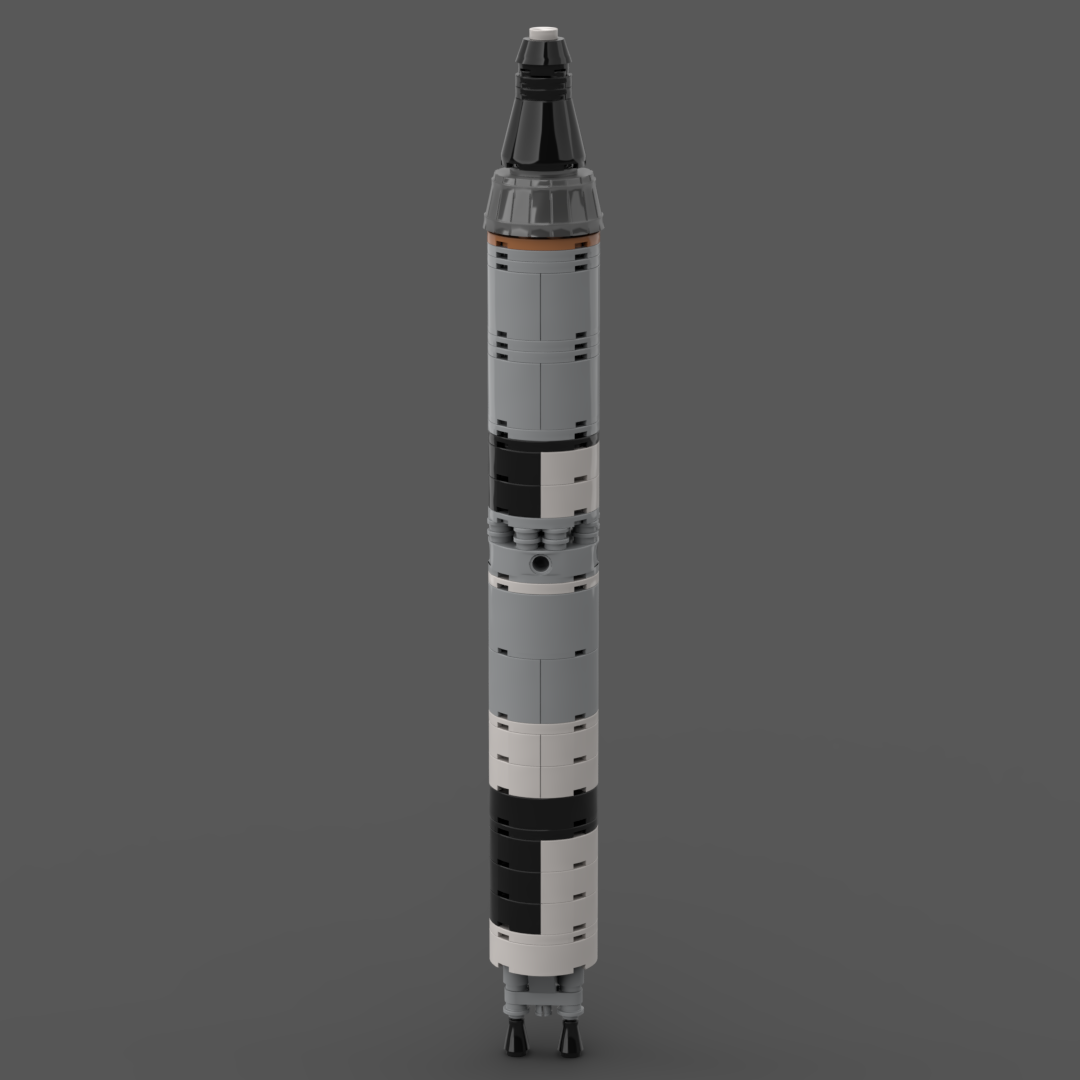
LEGO Designer:
Grant Passmore (Eiffelman)
Designed:
July 2017
Categories:
Launch Vehicles, All, Manned Spaceflight, Medium Lift Launch Vehicle, Space Agency - NASA
Launch Vehicle Details
Stages:
2 stage
Length:
32.8 m
Diameter:
3.05 m
Mass at Launch:
150 tonnes
Low Earth Orbit Capacity:
3600 kg
Total Thrust:
2090 kN
Apogee:
300 km
Class:
Medium Lift Launch Vehicle
The Titan II GLV (Gemini Launch Vehicle) or Gemini-Titan II was an American expendable launch system derived from the Titan II missile, which was used to launch twelve Gemini missions for NASA between 1964 and 1966. Two unmanned launches followed by ten manned ones were conducted from Launch Complex 19 at the Cape Canaveral Air Force Station, starting with Gemini 1 on April 8, 1964.
The Titan II was a two-stage liquid-fuel rocket, using a hypergolic propellant combination of Aerozine 50 fuel and nitrogen tetroxide oxidizer. The first stage was powered by an LR87 engine (with two combustion chambers and nozzles, fed by a single set of turbomachinery), and the second stage was propelled by an LR-91 engine.
Specifications
- Country of Origin: United States
- Manufacturer: Martin
- First Launched: April 8 1964
- Launch site: Cape Canaveral, Launch Complex 19
- Length: 109 feet (33.2 m)
- Diameter:10 feet (3.05 m)
- Launch Mass: 340,000 pounds (154,200 kg)
- Stages: 2
- Boosters: 0
- Payload to LEO: 7,900 pounds (3,580 kg)
Flight history
| Mission | LV serial No | Launch date | Crew |
| GT-I | GLV-1 12556 | April 8, 1964 | Unmanned orbital test flight |
| GT-II | GLV-2 12557 | January 19, 1965 | Unmanned suborbital test of Gemini heat shield |
| GT-III | GLV-3 12558 | March 23, 1965 | Gus Grissom and John Young |
| GT-IV | GLV-4 12559 | June 3, 1965 | James McDivitt and Ed White |
| GT-V | GLV-5 12560 | August 21, 1965 | Gordon Cooper and Charles P. Conrad |
| GT-VII | GLV-7 12562 | December 4, 1965 | Frank Borman and Jim Lovell |
| GT-VI A | GLV-6 12561 | December 15, 1965 | Wally Schirra and Thomas P. Stafford |
| GT-VIII | GLV-8 12563 | March 16, 1966 | Neil Armstrong and David Scott |
| GT-IX A | GLV-9 12564 | June 3, 1966 | Thomas P. Stafford and Eugene Cernan |
| GT-X | GLV-10 12565 | July 18, 1966 | John Young and Michael Collins |
| GT-XI | GLV-11 12566 | September 12, 1966 | Charles P. Conrad and Richard F. Gordon |
| GT-XII | GLV-12 12567 | November 11, 1966 | Jim Lovell and Edwin “Buzz” Aldrin |
Downloads
Stripes
Having had some success with using paper printed wraps on some of my rocket builds I look at the Roll patterns on the Gemini Titan II. This had two sections of black and white vertical markings, the best I could do in Lego was two black and two white stripes but there were four and four on the actual rocket. As before these marking are added by taping one edge of the wrap and wrapping it tightly around the rocket. it isn’t stuck to your bricks so they are undamaged. My first attempt at adding a strip was too loose and it slipped but the second go gave me the result I was looking for. I kept the original Lego stripe underneath and the brick joints were helpful in ligning up the patterns on the two wraps. The wrap was designed at 300 dpi.
Wrap
This paper wrap is for the white cone below the Gemini Capsule – This was the Retrograde and Equipment sections. The four paper tabs fit between the studs of the cone and hold it in place whent he capsule is attached. I used a craft knife to cut the tabs and I would recommend cutting the ends and then the sides of the tabs first before cutting the curves between the tabs. I just used some clear tape to join the cone together. This adds a little more detail on what I would hope would be a printed piece in the set.
Part count: 103 bricks, 33 lots.
| Unit | width | length | height |
|---|---|---|---|
| Studs | 4.3 | 4.3 | 38.1 |
| Inches | 1.4 | 1.4 | 12 |
| Centimetres | 3.5 | 3.5 | 30.5 |
No: Serial: Type: Date LS Payload
1 1 Titan-2-GLV 08.04.1964 CC LC-19 Gemini 1
2 2 Titan-2-GLV 19.01.1965 * CC LC-19 Gemini 2
3 3 Titan-2-GLV 23.03.1965 CC LC-19 Gemini 3
4 4 Titan-2-GLV 03.06.1965 CC LC-19 Gemini 4
5 5 Titan-2-GLV 21.08.1965 CC LC-19 Gemini 5 / REP
6 6 Titan-2-GLV 04.12.1965 CC LC-19 Gemini 7
7 7 Titan-2-GLV 15.12.1965 CC LC-19 Gemini 6A
8 8 Titan-2-GLV 16.03.1966 CC LC-19 Gemini 8
9 9 Titan-2-GLV 03.06.1966 CC LC-19 Gemini 9A / AMU
10 0 Titan-2-GLV 18.07.1966 CC LC-19 Gemini 10
11 11 Titan-2-GLV 12.09.1966 CC LC-19 Gemini 11
12 12 Titan-2-GLV 11.11.1966 CC LC-19 Gemini 12
Launch sites:
CC = Cape Canaveral Air Force Station, Eastern Test Range, Cape Canaveral, Florida, USA
Launch History information from space.skyrocket.de
Launch History information from space.skyrocket.de
Related Posts
None found

